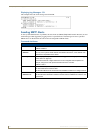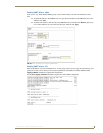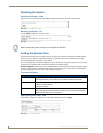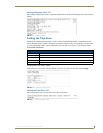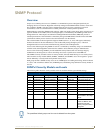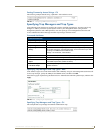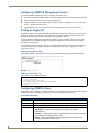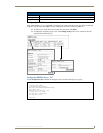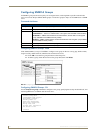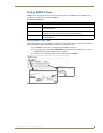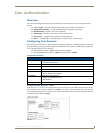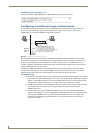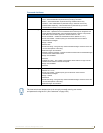
SNMP Protocol
50
NXA-ENET24 - Software Management Guide
Configuring SNMPv3 Management Access
To configure SNMPv3 management access to the switch, follow these steps:
1. If you want to change the default engine ID, it must be changed first before configuring other parameters.
2. Specify read and write access views for the switch MIB tree.
3. Configure SNMP user groups with the required security model (i.e., SNMP v1, v2c or v3) and security
level (i.e., authentication and privacy).
4. Assign SNMP users to groups, along with their specific authentication and privacy passwords.
Setting an Engine ID
An SNMPv3 engine is an independent SNMP agent that resides on the switch. This engine protects against
message replay, delay, and redirection. The engine ID is also used in combination with user passwords to
generate the security keys for authenticating and encrypting SNMPv3 packets.
A local engine ID is automatically generated that is unique to the switch. This is referred to as the default
engine ID. If the local engine ID is deleted or changed, all SNMP users will be cleared. You will need to
reconfigure all existing users.
A new engine ID can be specified by entering 1 to 26 hexadecimal characters. If less than 26 characters are
specified, trailing zeroes are added to the value. For example, the value “1234” is equivalent to “1234”
followed by 22 zeroes.
Setting an Engine ID - Web
Click SNMP, SNMPv3, Engine ID. Enter an ID of up to 26 hexadecimal characters and then click Save.
Setting an Engine ID - CLI
This example sets an SNMPv3 engine ID.
Configuring SNMPv3 Users
Each SNMPv3 user is defined by a unique name. Users must be configured with a specific security level and
assigned to a group. The SNMPv3 group restricts users to a specific read and a write view.
Command Attributes
FIG. 45 Setting an Engine ID
Console(config)#snmp-server engine-id local 12345abcdef
Console(config)#exit
Console#show snmp engine-id294
Local SNMP engineID: 12345abcdef000000000000000
Local SNMP engineBoots: 1
Console#
Command Attributes
• User Name: The name of user connecting to the SNMP agent. (Range: 1-32 characters)
•Group Name: The name of the SNMP group to which the user is assigned. (Range: 1-32 characters)
•Model: The user security model; SNMP v1, v2c or v3.
• Level: The security level used for the user:
• noAuthNoPriv – There is no authentication or encryption used in SNMP
communications.
• AuthNoPriv – SNMP communications use authentication, but the data is not encrypted
(only available for the SNMPv3 security model).
• AuthPriv – SNMP communications use both authentication and encryption (only
available for the SNMPv3 security model).



